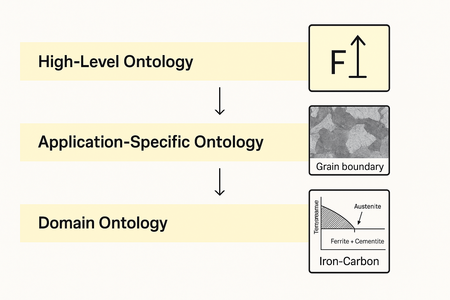
This Infrastructure Use Case (IUC12) aims to demonstrate how the alignment of domain or application ontologies to higher-level ontologies enables the interoperability between different domain-specific ontologies and with this between different data bases. Furthermore, it is one of the prerequisites for creating a well-connected “network” of ontologies across different NFDI consortia. One of the main challenges is the dynamic alignment of ontologies that are constantly changing and developing.
When developing their domain or application specific ontologies, the contributing Participant Projects match the entities of their ontologies to other domain, - application- or general ontologies. Within ontology development and alignment, a close interaction with NFDI4Ing, in particular with regards to their base services Measure S-3 “Metadata and terminology services”, FAIRmat and PMDco is planned. The Linked Open Data (LOD) working group acts as an interactive platform for the interdisciplinary collaboration between domain experts and provides technical support for ontology development and alignment.
| Main requirements: - Preferably existing application/domain or general ontologies - Structured Metadata - Basis ontology advisory - Ontology development support - Software interfaces for ontology alignment |
| Main Task Area: TA-SAI Other related Task Areas: TA-SD |
| Possible connections within NFDI: All consortia, in particular NFDI4Ing, FAIRmat, NFDI4Chem |
| Material/Data: - Other ontologies, e.g., BFO, EMMO (Elementary Multiperspective Material Ontology), PMDco, ontologies from NIST (National Institute of Standards and Technology) - Structured Metadata - Specification on Ontology regarding Scope and Purpose from PPs |
| Main Success Scenario: Users can easily connect application- and higher-level ontologies with general ontologies. |
| Added value for the MatWerk community: Consistent interfaces with all neighboring communities and benefit from their expertise. |
Two exemplary case studies were selected in the end of the first funding period, which fulfil the requirement of an existing ontology so that they can now be aligned to higher-level ontologies.
Case 1: The DISO-Dislocation Ontology, developed in PP11 is a module of the CDOS-Crystallographic Defect Ontology Suite and is aligned with higher-level ontologies such as EMMO and QUDT, which represent concepts like crystal structure and material. Data from DISO and CDOS can be used e.g. in atomistic simulations. Therefore, those ontologies need to be connected to ontologies, which describe the concepts of simulation, such as CMSO-Computational Material Sample Ontology and MMSS-Materials Modelling and Simulation Suite through alignment with the Basic Formal Ontology (BFO). This ensures compatibility across ontologies on a general level.
The alignment workflow is being established within IUC12 and the Linked Open Data Working Group. Interoperability will be further demonstrated in PP21 through workflows and data schemas developed for characterizing grain boundaries via atomistic simulations. These descriptions will be aligned with CDOS to ensure applicability across various scientific disciplines.
Case 2: The SI Reference Point describes an authoritative digital reference for the International System of Units (SI). It provides Permanent Digital Identifiers (PIDs) for the named SI units, SI prefixes, and defining constants, and a parsing tool for the PID and semantic model for compound units. The SI Reference Point - Base Ontology is part of the SI reference point and provides base concepts and their relations. This ontology is particularly important for the representation of measures, quantities, constants and units in different application or domain level ontologies. On the other hand, the SI Reference point ontology can be aligned to other ontologies, which represent the concept of quantities and units, such as QUDT but also to general higher level-ontologies, such as the Basic Formal Ontology (BFO).
NFDI-MatWerk
Funded by the Deutsche Forschungsgemeinschaft (DFG, German Research Foundation) under the National Research Data Infrastructure – NFDI 38/1 – project number 460247524.
NFDI-MatWerk
Funded by the Deutsche Forschungsgemeinschaft (DFG, German Research Foundation) under the National Research Data Infrastructure – NFDI 38/1 – project number 460247524.
Subscribe to our newsletter for regular updates about materials science topics!
After subscribing, you will receive an email from us with a confirmation
link.
Only after clicking this link your registration is completed.